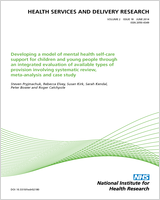NCBI Bookshelf. A service of the National Library of Medicine, National Institutes of Health.
Headline
This single-area study found that implementation of electronic referral management, when combined with clinical triage, can lead to diversions of appropriate oral surgery cases to primary care
Abstract
Background:
Oral surgery referrals from dentists are rising and putting increased pressure on finite hospital resources. It has been suggested that primary care specialist services can provide care for selected patients at reduced costs and similar levels of quality and patient satisfaction.
Research questions:
Can an electronic referral system with consultant- or peer-led triage effectively divert patients requiring oral surgery into primary care specialist settings safely, and at a reduced cost, without destabilising existing services?
Design:
A mixed-methods, interrupted time study (ITS) with adjunct diagnostic test accuracy assessment and health economic evaluation.
Setting:
The ITS was conducted in a geographically defined health economy with appropriate hospital services and no pre-existing referral management or primary care oral surgery service. Hospital services included a district general, a foundation trust and a dental hospital.
Participants:
Patients, carers, general and specialist dentists, consultants (both surgical and Dental Public Health), hospital managers, commissioners and dental educators contributed to the qualitative component of the work. Referrals from primary care dental practices for oral surgery procedures over a 3-year period were utilised for the quantitative and health economic evaluation.
Interventions:
A consultant- then practitioner-led triage system for oral surgery referrals embedded within an electronic referral system for oral surgery with an adjunct primary care service.
Main outcome measures:
Diagnostic test accuracy metrics for sensitivity and specificity were calculated. Total referrals, numbers of referrals sent to primary care and the cost per referral are reported for the main intervention. Qualitative findings in relation to patient experience and whole-system impact are described.
Results:
In the diagnostic test accuracy study, remote triage was found to be highly specific (mean 88.4, confidence intervals 82.6 and 92.8) but with lower values for sensitivity. The implementation of the referral system and primary care service was uneventful. During consultant triage in the active phases of the study, 45% of referrals were diverted to primary care, and when general practitioner triage was used this dropped to 43%. Only 4% of referrals were sent from specialist primary care to hospital, suggesting highly efficient triage of referrals. A significant per-referral saving of £108.23 [standard error (SE) £11.59] was seen with consultant triage, and £84.13 (SE £11.56) with practitioner triage. Cost savings varied according the differing methods of applying the national tariff. Patients reported similar levels of satisfaction for both settings, and speed of treatment was their over-riding concern.
Conclusions:
Implementation of electronic referral management in primary care can lead, when combined with triage, to diversions of appropriate cases to primary care. Cost savings can be realised but are dependent on tariff application by hospitals, with a risk of overestimating where hospitals are using day case tariffs extensively.
Study limitations:
The geographical footprint of the study was relatively small and, hence, the impact on services was minimal and could not be fully assessed across all three hospitals.
Future work:
The findings suggest that the intervention should be tested in other localities and disciplines, especially those, such as dermatology, that present the opportunity to use imaging to triage.
Funding:
The National Institute for Health Research Health Services and Delivery Research programme.
Contents
- Plain English summary
- Scientific summary
- Chapter 1. Structure of the research and this report
- Chapter 2. Efficiency of remote clinical triage
- Chapter 3. Implementation and health needs assessment (phase 1)
- Chapter 4. Active referral management with consultant and general dental practitioner triage: quantitative findings including economic evaluation (phases 2 and 3)
- Chapter 5. Active referral management with consultant and general dental practitioner triage qualitative findings (phases 2 and 3)
- Chapter 6. Conclusions
- Acknowledgements
- References
- Appendix 1. Oral surgery complexity levels
- Appendix 2. Qualitative interview participants
- Appendix 3. Oral surgery referral form
- Appendix 4. Normalisation process theory framework
- Appendix 5. Patient questionnaire
- Appendix 6. Reflexive statement
- Glossary
- List of abbreviations
About the Series
Article history
The research reported in this issue of the journal was funded by the HS&DR programme or one of its preceding programmes as project number 11/1022/15. The contractual start date was in December 2012. The final report began editorial review in March 2017 and was accepted for publication in July 2017. The authors have been wholly responsible for all data collection, analysis and interpretation, and for writing up their work. The HS&DR editors and production house have tried to ensure the accuracy of the authors’ report and would like to thank the reviewers for their constructive comments on the final report document. However, they do not accept liability for damages or losses arising from material published in this report.
Declared competing interests of authors
Iain Pretty is involved with the delivery of referral management services to NHS England, for which he receives financial reward. He was involved with the development of early pilot models in referral management at NHS Trafford. He was involved in the evaluation of the Index of Sedation Need (IOSN) tool. Paul Coulthard chaired the Oral Surgery and Oral Medicine Working group that developed the Guide for Commissioning Oral Surgery and Oral Medicine. This guide advocated the use of referral management systems in pathway management. He was involved in the development of the IOSN tool.
Last reviewed: March 2017; Accepted: July 2017.
- NLM CatalogRelated NLM Catalog Entries
- An evaluation of a referral management and triage system for oral surgery referr...An evaluation of a referral management and triage system for oral surgery referrals from primary care dentists: a mixed-methods study
Your browsing activity is empty.
Activity recording is turned off.
See more...
